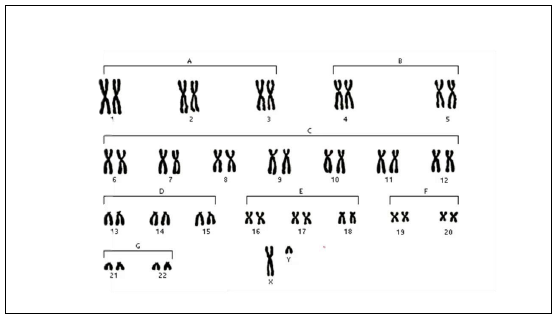Questões de Vestibular UDESC 2017 para Vestibular - Segundo Semestre (Manhã)
Foram encontradas 50 questões

Figura 2
A Figura 2 mostra exemplares (macho e fêmea) de um caranguejo gigante, cujas garras podem ultrapassar 1 m de comprimento. Estes animais pertencem à classe dos crustáceos a qual também possui representantes quase invisíveis que, juntamente com outros organismos (algas e bactérias fotossintetizantes), constituem uma comunidade de seres flutuantes que servem de base alimentar para a maior parte da fauna aquática.
Esta comunidade de seres flutuantes é denominada:

Figura 3
Fonte: https://www.youtube.com/watch?v=2B9unRdTvXw
Na Figura 3 é mostrado um cariótipo. Analise as proposições em relação aos cariótipos e assinale (V) para verdadeira e (F) para falsa.
( ) Pelo cariótipo apresentado, pode-se deduzir que o número haploide (n) desta espécie é igual a 23.
( ) Neste cariótipo são observados 23 pares de homólogos.
( ) Constata-se um caso de trissomia com translocação no par de número 22, neste cariótipo.
( ) Neste cariótipo o primeiro par de cromossomos homólogos é do tipo metacêntrico.
( ) Se este cariótipo fosse um indivíduo que apresentasse Mosaisismo poder-se-ia encontrar cariótipos diferentes.
Assinale a alternativa que contém a sequência correta, de cima para baixo.
No quadro a seguir, as colunas A, B e C indicam, respectivamente, glândulas, hormônios e suas ações.
Coluna A
Glândula
I - Hipófise
II - Ovário
III - Testículo
Coluna B
Hormônio
A) - FSH
B) - LH
C) - Prolactina
D) - Estrógeno
E) - Progesterona
F) - Testosterona
Coluna C
Principais ações
1) Maturação dos órgãos reprodutores.
2) Desenvolvimento das glândulas mamárias.
3) Estimula o desenvolvimento do folículo, a secreção de estrógeno e a ovulação.
4) Estimula a ovulação.
5) Estimula a produção de leite após o desenvolvimento das glândulas mamárias.
6) Desenvolvimento de características sexuais secundárias.
Adaptado de Amabis e Martho, Biologia dos Organismos, vol 2, 2ª ed., Moderna, p. 574
Assinale a alternativa que contempla todas as associações corretas.
TEXT 1
Fruit Juice, in Moderation, Not Tied to Obesity in Children
…………………….experts believe that drinking fruit juice may lead to obesity in children, but a new review has found that juice in moderation does not cause excess weight gain in children under 18.
Researchers pooled data……………… eight prospective observational studies of the association between regular 100 percent fruit juice consumption and weight gain. The analysis, published in Pediatrics, includes 34,470 boys and girls under 18.
The studies used something called the B.M.I. z score, …………………….statistically adjusts body mass index according to age. Changes in these scores of 0.25 to 0.50 are generally considered to put the child at risk for obesity.
After controlling for total energy intake, birth weight, ethnicity and other factors, a 6- to 8-ounce daily serving of 100 percent fruit juice was associated with a 0.087 unit average increase in B.M.I. z score in children 1 to 6 — equivalent to about 0.3 pounds. In those 7 to 18, there was no link ……………….. all between drinking fruit juice and weight gain.
The lead author, Dr. Brandon J. Auerbach, an acting instructor in medicine at the University of Washington, said that based ……………………. the current evidence, “consuming one daily serving of fruit juice is not associated with weight gain in children. So fruit juice in moderation, not more than a serving a day, is safe.”
By NICHOLAS BAKALAR. Avaiable at: www.nytimes.com/section/health. (accessed on March 27th, 2017)
Answer the question, according to Text 1
TEXT 1
Fruit Juice, in Moderation, Not Tied to Obesity in Children
…………………….experts believe that drinking fruit juice may lead to obesity in children, but a new review has found that juice in moderation does not cause excess weight gain in children under 18.
Researchers pooled data……………… eight prospective observational studies of the association between regular 100 percent fruit juice consumption and weight gain. The analysis, published in Pediatrics, includes 34,470 boys and girls under 18.
The studies used something called the B.M.I. z score, …………………….statistically adjusts body mass index according to age. Changes in these scores of 0.25 to 0.50 are generally considered to put the child at risk for obesity.
After controlling for total energy intake, birth weight, ethnicity and other factors, a 6- to 8-ounce daily serving of 100 percent fruit juice was associated with a 0.087 unit average increase in B.M.I. z score in children 1 to 6 — equivalent to about 0.3 pounds. In those 7 to 18, there was no link ……………….. all between drinking fruit juice and weight gain.
The lead author, Dr. Brandon J. Auerbach, an acting instructor in medicine at the University of Washington, said that based ……………………. the current evidence, “consuming one daily serving of fruit juice is not associated with weight gain in children. So fruit juice in moderation, not more than a serving a day, is safe.”
By NICHOLAS BAKALAR. Avaiable at: www.nytimes.com/section/health. (accessed on March 27th, 2017)
Answer the question, according to Text 1